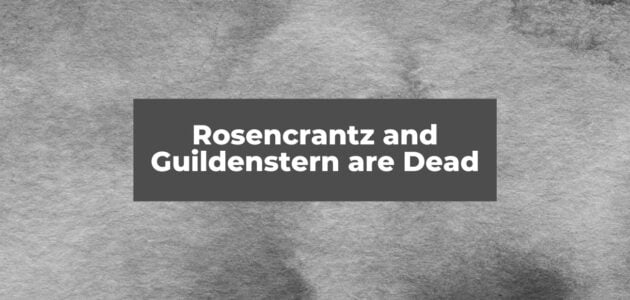
Rosencrantz and Guildenstern are Dead (Stoppard)
Play Synopsis
The title of this Tom Stoppard play, Rosencrantz and Guildenstern are Dead, is taken from the final scene of Shakespeare’s Hamlet. Rosencrantz and Guildenstern are two minor characters from Hamlet, but Stoppard’s play sees this reversed, with Rosencrantz and Guildenstern becoming the main characters and the other, more central, Hamlet characters being reduced to minor roles.
By turning Hamlet on its head, Stoppard creates an absurdist play that examines existentialist themes that were contemporary when the play was written and first performed in the 1960s, and that remain relevant in today’s theatre. These themes include free will and fate, reality and art, the absurdity of life, the difficulty of making meaningful communication, and the inevitability of death,
For most of the play, the action takes place backstage, in the wings of a performance of Shakespeare’s Hamlet, with the action of both plays coinciding now and then. In Shakespeare’s Hamlet, Rosencrantz and Guildenstern are old friends of Hamlet who are used by the king to ascertain information about Hamlet, and they transport a letter ordering his death. Hamlet ends up tricking them by switching the letter to one that orders the deaths of Rosencrantz and Guildenstern, and they are killed in his place, allowing Hamlet to return to Denmark from exile in England.
The nature of their roles means that they don’t understand what is going on in Hamlet, so, for much of the play, they are confused; stalling for time by playing games, asking questions, musing over the meaning of life, all in long silences (in between their involvement in Hamlet itself). They also role-play, acting out scenes from Hamlet, in order to try to more fully understand their roles.
The play offers a different interpretation of a familiar story, in order to raise questions about the truth of reality. The two characters are carried along by the plot of Hamlet, with no real control over their lives, but they are minor characters, with no real purpose, leading to their questioning of life. They frequently can’t remember or aren’t sure how they have arrived at a particular scene and, as the play progresses, they torture themselves over what they might have done or what opportunity they might have missed that has led to their fate.
Rosencrantz and Guildenstern are Dead uses the technique of meta-theatre, which means that it often draws attention to its own theatricality, rather than aiming to produce realism or tell a story as such. The play frequently draws a comparison to Beckett’s Waiting for Godot, using similar techniques and motifs, and two characters that often seem to be two halves of one person.
Rosencrantz and Guildenstern are Dead Quotes
We’re actors — we’re the opposite of people!
Life is a gamble, at terrible odds. If it were a bet you wouldn’t take it.
Rosencrantz and Guildenstern are Dead piqued your interest? Check out our list of Best Tom Stoppard Plays.

Leave a Reply